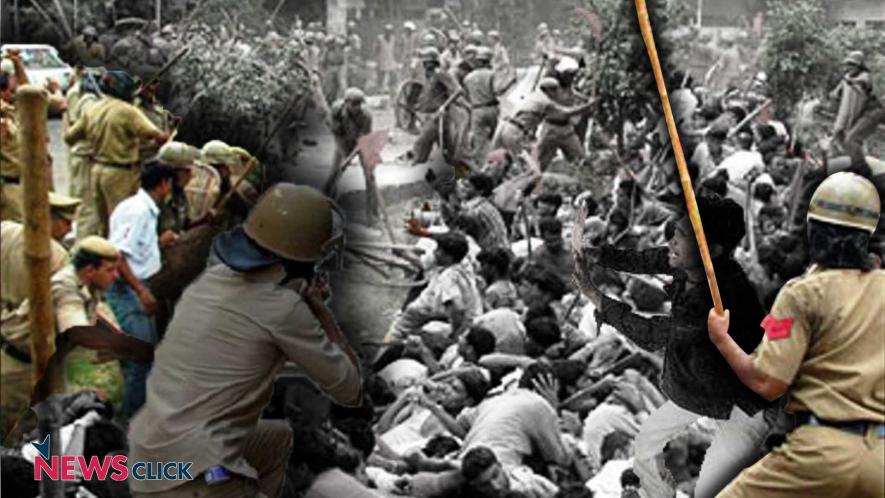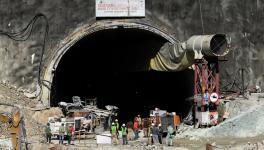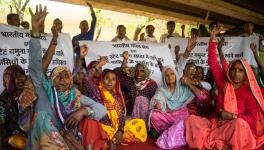Kalinganagar Police Firing in 2006 That Killed 13 Tribals was Justified, Says Enquiry Commission

Newsclick Image by Sumit
“In my considered opinion, there was no option for the Executive Magistrate than to pass orders for opening of live firing on the riotous mob when all deterrent measures i.e. firing of Tear Gas shells, Stinger shells, Stun shells and then firing of Rubber 88 bullets and the firing to air failed to scare away and disperse the mob.”This is how the Justice Mohanty Commission Report, tabled in Odisha Assembly on Thursday justified the Kalinganagar police firing on January 2, 2006 which killed 13 tribals.
The Commission headed by Justice Pradyumna Kumar Mohanty was appointed on February 4, 2006, to probe into the police firing at Kalinganagar in Jajpur district, Odisha. Though the inquiry commission had a tenure of six months, its tenure was extended until July 3, 2015. The commission submitted the report on time, but the government accepted it only on June 8, 2016.
The report which gave a clean chit to the state government and law enforcement agencies caused anger among civil society groups and rights activists. In a press statement, the activists from Odisha questioned the report which, they alleged, “justifies state violence on citizens”.
Though the report mentioned that the expressions of discontent over the acquisition of land, between 1990 to 1995 and from 1995 to 2005, were peaceful and democratic, it hasn’t pointed out that the administration and elected representatives in power have been responsible for the increasing discontent of the people regarding compensation and rehabilitation. Questioning this, the activists observed if the “discontent had been addressed instead of working in favour of the company, such a tragic incident of firing and loss of lives would not have happened.”
The state government has started to acquire the land from the locals since 1990 to create an industrial complex initially named “Duburi Industrial complex”, but subsequently renamed as Kalinga Nagar Integrated Industrial Complex (for short KNIIC) to attract the industrial houses to set up their Iron, steel and Allied industries in the area. The state which has almost 60% of India’s known bauxite reserve, 25% of coal, 98% of chromites, 28% of iron ore, 92% of nickel ore, 28% of manganese, etc. acquired the land from locals, giving them a view and hope that setting up of industries in the area would create job opportunities and generate employment for them. Along with such views, the government promised adequate compensation and proper resettlement to the families facing displacement.
“The promise of employment to the natives remained largely unfulfilled. While most of the higher level posts are occupied by the elites in the locality and outsiders, the diseased community was often denied such jobs citing insufficient education”, said Narendra Mohanty, state convener of Indian Social Action Forum, while speaking to Newsclick.
“The compensations offered by the government were very less. Earlier it was just Rs 35,000 per acre of land and the government increased the amount to Rs 1 lakh after continuous demands and protests. Still, the people, who were thrown out of their land, are suffering to make their lives”, Narendra added.
Following all these incidents, the police have resorted to brutal lathi charges in the year 2010 and 2011. No one was there to protect the people, the administration held their position by standing alongside with the private firms. In 2015 and 2016, some families were forced to move out of their land too, Narendra portrayed continuing pressure on the native people in that area.
Again the Commission has said that near about 1000 villagers on January 2, 2006, gathered with lathis, axes, bows and arrows and posed a threat to the construction of the boundary wall of Tata. Therefore 12 platoons of police (over 500 armed police personnel) were stationed with modern arms and weapons to maintain the law and order. Relying on the statement of the commission, the activists raised the question 'Can the lathis, axes, bows and arrows of the people, that were deemed to be “deadly weapons” stand against the modern arms and ammunition of the Odisha police?'
The activists further questioned the ‘biased’ report of the commission by asking: Why was the gathering of those villagers with their traditional weapons to protect their lands and livelihoods termed ‘illegal’ and ‘unconstitutional’, but the presence of such a large contingent of armed police for the construction works of a private company like Tata was seen as “adequate” and “cannot be faulted”?
“The protection of the interests of a corporate entity like Tata, is the sole concern of the Commission like other Commissions have done in the past,” the press statement said referring to biases of government commissions like the earlier Mishra Commission report. This Commission was constituted to inquire into the police firing in December 2000 in Rayagada district where three tribals were killed and seven injured. The people were fighting against bauxite mining and alumina plant of Aditya Birla Group.
Again, the commission had questioned the role of political activists and NGOs from events around May 2005 and onwards who, according to the Commission, had “taken advantage of the volatile situation, mobilised, instigated and led the villagers to adopt a path of confrontation.”
In this context, Debaranjan of Ganatantrik Adhikar Surakhya Sangathan asked: “Why has the commission hesitated to question the role of administration in the entire incidents?”
In KNIIC, 13,000 acres of land was earmarked and the Commission has highlighted that 7,057 acres belong to the private owners. Most of the private land in this area was claimed as public land which the government arbitrarily sold to a private company. This was one of the main grievances of the people. In this context, the activists have asked the commission which had ample opportunity to question the state government “Why measures had not been taken to implement land settlements as per the Odisha Survey and Settlement Act before declaring the area as Kalinganagar Industrial Complex”.
“Apart from this, Tata has encroached on the forest land and the Eastern Zone Bench of the National Green Tribunal (NGT) had issued a notice to Tata Steel and the Odisha government,” alleged Debaranjan mentioning the illegal construction of boundary walls and cutting of trees by Tata Steel for the proposed extension of its steel plant on forest land in the area.
While disapproving the action of doctors who conducted an autopsy on the bodies of five deceased killed in police firing, the report further said the doctors had clearly deviated from the normal practice and procedure by severing the palms from dead bodies without authority and contrary to the request made by the police.
Finally the activists criticised the commission, which made it “clear that citizens have no right to protect their own lives and livelihood”, and its justification of this large presence of police resorting to barbaric violence for their “own self-defence” leading to the killing of 13 Adivasis, once again establishes the monopoly of violence that the State and administration carry.
The activists will stage a collective protest on January 2, 2018, against the police firing and the state repression on people’s movements struggling for the protection of land and livelihoods.
Get the latest reports & analysis with people's perspective on Protests, movements & deep analytical videos, discussions of the current affairs in your Telegram app. Subscribe to NewsClick's Telegram channel & get Real-Time updates on stories, as they get published on our website.
























